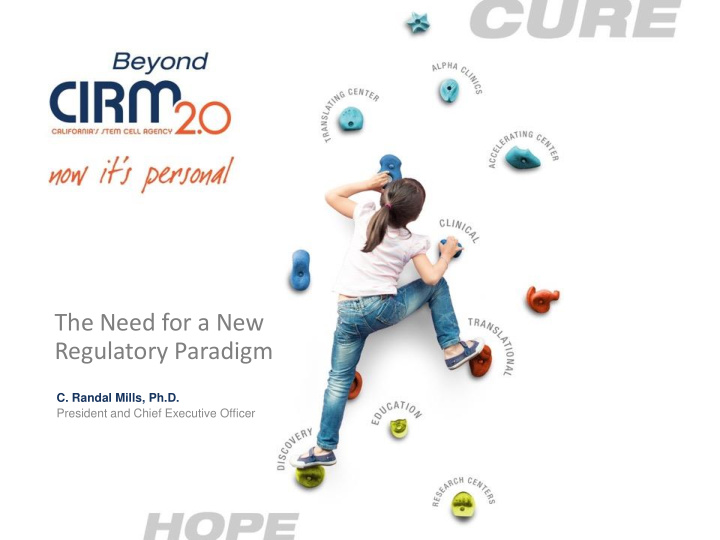



The Need for a New Regulatory Paradigm C. Randal Mills, Ph.D. President and Chief Executive Officer
Our Mission MISSION To accelerate stem cell treatments to patients with unmet medical needs
The CIRM Strategic Plan We are ALL IN 3
The current regulatory pathway FDA was the most frequently cited impediment to developing stem cell treatments The percentage of survey as an impediment 70 respondents that view FDA 4
Promised vs. Delivered FDA originally proposed a “tiered” approach “Under this tiered, risk -based approach, we propose to exert only the type of government regulation necessary to protect the public health.” “The regulation of different types of human cells… will be commensurate with the public health risks presented…” “These planned improvements will increase the safety of human cells… while encouraging the development of new products.” 5
Promised vs. Delivered A progressive approach was promised, where regulation scaled with risk PROMISED REGULATION RISK 6
Promised vs. Delivered Instead, we received binary regulation that is either OFF or ON DELIVERED PROMISED REGULATION REGULATION RISK RISK 7
This is A Real Problem It leads to both Under and Over regulation Overregulated REGULATION Underregulated RISK 8
The Effects of the System The current approach drives sub-optimal behavior 9
This Causes Inconsistent Application FDA attempts to compensate with selected enforcement • The cells from corneas have been successfully transplanted for more than 50 years • Last year alone, 47,000 Americans had their eye sight restored through corneal cell transplantation • If FDA enforced its current regulations, surgeons would not be allowed to perform this procedure • Uncertainty has a chilling effect on new product development 10
As a Result Performance Suffers The number of stem cell 0 products approved by FDA after 15 years under the current paradigm 11
The Three Reasons We Need A New Approach The current system: Is not the tiered approach promised and needed It is inconceivable that the entire spectrum of cell therapies can be appropriately regulated with an “ ON-OFF ” switch Is inconsistently applied to compensate for itself The regulation is arbitrarily followed by the agency that created it – driving uncertainty for those developing new products Has delivered poor results By having a system that approves nothing after 15 years, we are neither protecting nor helping those in need 12
For Clarity CIRM does not oppose regulation and does not support the abolition of regulation CIRM is not anti-FDA We do believe that the regulatory burden placed upon the development of cell therapies must: be scaled to more accurately reflect the risks, be balanced against the very real consequences of doing nothing, and be fairly and consistently applied. • CIRM is not wed to any single approach. We only want to see the problem fixed … now. 13
The System Can Be Fixed And used to drive better outcomes for patients 14
We all need to IMAGINE BETTER and ACT 15
Recommend
More recommend